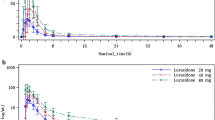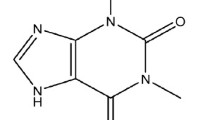Summary
The kinetics of chlorthalidone in blood and urine were analysed in one group of 6 healthy volunteers after single oral doses of 50, 100 and 200 mg, as well as in a second group of 6 volunteers during and after daily oral doses of 50 mg for 14 days. The mean maximal concentrations recorded in blood 8 h after the three different doses were 3.15 µg/ml (SD±0.52), 5.55±1.58 µg/ml and 7.93±1.40 µg/ml, respectively. Disappearance of chlorthalidone from blood followed an apparent first order type of reaction, the average half life t50 being 49 h (SD 11 h). Total renal elimination of unchanged chlorthalidone amounted to 53.3±8.7%, 46.1±8.4% and 34.0±7.3% of the single 50, 100 and 200 mg doses. Between the 6th and 14th days of daily treatment the concentration at the end of the 24 h dose interval was 7.2±1.4 µg/ml (± 1.4) in blood and 186±44 ng/ml in plasma. Except in the early absorption phase after each dose, the distribution of chlorthalidone between erythrocytes and plasma was constant, the average plasma concentration being 1.38±0.28% (n=75) of the whole blood concentration. At steady state during daily dosing with chlorthalidone 50 mg, the renal elimination of unchanged chlorthalidone within each 24 h dose interval was 57±11.2% of the daily dose. The renal plasma clearance ranged from 46 to 70 ml/min. Following termination of repeated administration the concentration of chlorthalidone in blood decreased with a t50=50±5 h and in plasma with t50=49±4.8 h.
Similar content being viewed by others
References
Graf, W., Girod, E., Schmid, E., Stoll, W. G.: Zur Konstitution von Benzophenon-2-carbonsäure-Derivaten Helv. chim. acta42, 1085–1101 (1959)
Stenger, E. G., Wirz, H., Pulver, R.: Hygroton® (G 33 182), ein neues Salidiureticum mit protrahierter Wirkung Schweiz. Med. Wschr.89, 1126–1130 (1959)
Ervik, M., Gustavii, K.: Application of the extractive alkylation technique to the gas chromatographic determination of chlorthalidone in plasma in nanogram quantities. Anal. Chem.46, 39–42 (1974)
Wagner, J., Nelson, E.: Per cent absorbed time plots derived from blood level and/or urinary excretion data J. Pharm. Sci.52, 610–611 (1963)
Dost, F. H.: Grundlagen der Pharmakokinetik. p. 278. Stuttgart: Georg Thieme 1968
Buenger, O., Diller, W., Fuehr, J., Krueger-Thiemer, E.: Vergleichende Untersuchungen an neueren Sulfonamiden. 1. Mitt. Arzneim. Forsch.11, 247–255 (1961)
Wagner, J. G.: Pharmacokinetics. 2. The kidney and urinary excretion Drug Intelligence2, 95–99 (1968)
Dieterle, W., Wagner, J., Faigle, J. W.: Binding of chlorthalidone (Hygroton®) to blood components in man Europ. J. clin. Pharmacol.10, 37–42 (1976)
Author information
Authors and Affiliations
Rights and permissions
About this article
Cite this article
Riess, W., Dubach, U.C., Burckhardt, D. et al. Pharmacokinetic studies with chlorthalidone (hygroton®) in man. Eur J Clin Pharmacol 12, 375–382 (1977). https://doi.org/10.1007/BF00562454
Received:
Accepted:
Issue Date:
DOI: https://doi.org/10.1007/BF00562454




